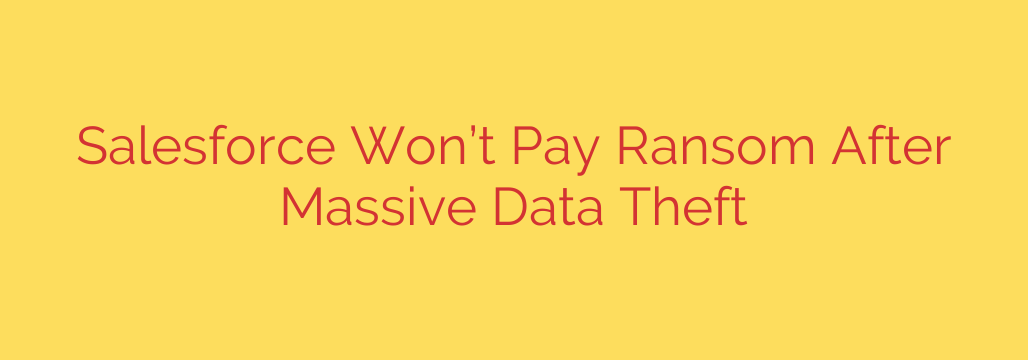
Salesforce Data Breach: What Happened and How to Protect Your Business
A significant security incident has impacted Salesforce, a giant in the customer relationship management (CRM) space, highlighting the growing threat of third-party data breaches. While Salesforce’s core systems were not directly compromised, a threat actor successfully stole a large volume of data from a third-party cloud environment, raising serious questions about supply chain security.
Following the data theft, the attackers demanded a ransom. In a decisive move, Salesforce has publicly confirmed it will not pay the ransom demand, taking a firm stance against funding criminal enterprises. This incident serves as a critical case study for businesses on the evolving nature of cyber threats and the importance of a robust security posture.
Unpacking the Breach: A Third-Party Point of Failure
The breach did not originate from a vulnerability within Salesforce’s own infrastructure. Instead, the attackers gained access to data stored on a separate cloud platform. Investigations indicate that the threat actors used previously stolen credentials to access a database belonging to Salesforce.
This method underscores a critical vulnerability for modern enterprises: your organization’s security is only as strong as your weakest partner’s. Attackers are increasingly targeting third-party vendors and cloud service providers as a backdoor to access the valuable data of their larger clients. The stolen data reportedly includes sensitive internal information and potentially customer metadata, which could be exploited in future phishing or social engineering attacks.
The Growing Threat of Supply Chain Attacks
This incident is a textbook example of a supply chain attack, where malicious actors infiltrate a company’s systems through an outside partner or provider. Because businesses rely on a complex web of vendors for everything from cloud storage to software development, a single compromised vendor can create a domino effect.
Key takeaways from this type of attack include:
- Credential Security is Paramount: The breach was enabled by stolen login credentials. This emphasizes that even the most secure networks can be compromised if user credentials fall into the wrong hands.
- Third-Party Risk is Your Risk: You cannot outsource responsibility for your data’s security. It is essential to vet the security practices of every vendor with access to your systems or information.
- Ransom Refusal is a Principled Stand: By refusing to pay, Salesforce avoids funding the cybercrime ecosystem. While this may risk the public release of stolen data, security experts often advise against paying ransoms, as it does not guarantee the data will be deleted and marks the victim as a willing target for future attacks.
Actionable Security Measures to Protect Your Data
While it’s impossible to eliminate all cyber risks, you can take proactive steps to significantly strengthen your defenses against incidents like this one. Here are essential security measures every business should implement today.
Enforce Multi-Factor Authentication (MFA): This is the single most effective tool against credential theft. MFA should be mandatory for all users, especially for accessing sensitive systems like your CRM, cloud platforms, and internal databases. It adds a critical layer of security that a stolen password alone cannot bypass.
Conduct Regular Vendor Security Audits: Don’t just trust that your partners are secure—verify it. Before onboarding a new vendor and on a recurring basis, conduct thorough security assessments. Ask for compliance certifications (like SOC 2 or ISO 27001) and understand their incident response protocols.
Implement the Principle of Least Privilege: Ensure that employees and third-party vendors only have access to the data and systems absolutely necessary for their jobs. Limiting access minimizes the potential damage if an account is compromised.
Monitor for Compromised Credentials: Utilize services that scan the dark web for your company’s email domains and employee credentials. Early detection of a compromised password allows you to force a reset before an attacker can use it.
Develop a Comprehensive Incident Response Plan: Don’t wait for a breach to happen to figure out what to do. A clear, tested incident response plan ensures your team can act quickly to contain the threat, assess the damage, and communicate effectively with stakeholders and customers.
Navigating the New Era of Cloud Security
The Salesforce data theft is a powerful reminder that in our interconnected digital world, security is a shared responsibility. Protecting your organization requires a defense-in-depth strategy that extends beyond your own network to encompass every vendor in your supply chain. By prioritizing strong authentication, continuous monitoring, and rigorous vendor management, you can build a more resilient organization prepared to face the sophisticated threats of today.
Source: https://www.bleepingcomputer.com/news/security/salesforce-refuses-to-pay-ransom-over-widespread-data-theft-attacks/








